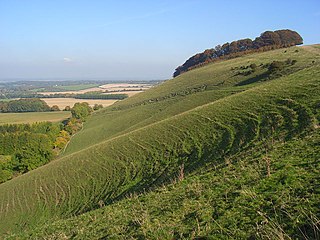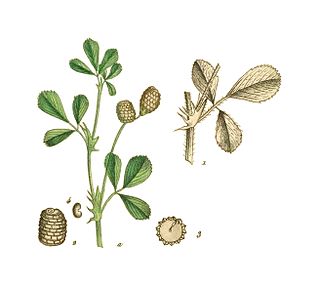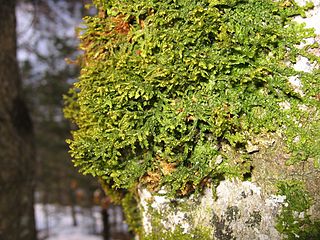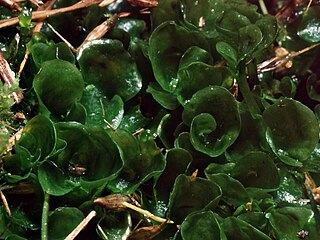
A swizzle stick is a small stick used to stir drinks. The original swizzle sticks were created in the 18th century at a rum plantation in the West Indies using the branch of the Quararibea turbinata. In the late 19th and early 20th centuries, stir sticks made of glass were created to shake out the bubbles from champagne, whose carbonation caused indigestion for some drinkers.

Ham Hill is a hill and area of chalk downland in Wiltshire, England, on the steep banks running alongside the road from the village of Ham to Buttermere, close to the Berkshire border. A biological Site of Special Scientific Interest, notified in 1971, covers 1.5 hectares of the site; this designation is due to the site's species-rich plant and insect communities, which include some rare species. Notable among these is the musk orchid, which has been confirmed at only one other site in Wiltshire.
Raddi is a surname. Notable people with the surname include:

Medicago turbinata, the Southern medick, is a plant species of the genus Medicago It is found throughout the Mediterranean basin. It forms a symbiotic relationship with the bacterium Sinorhizobium medicae, which is capable of nitrogen fixation. An unidentified lectin isolated from M. turbinata has shown limited usefulness as a phytohaemagglutinin. The seed weight is 4.66 pounds.

Porellaceae is a family of liverworts in the order Porellales. It which originally created with just two genera, Ascidiota, and Porella.

Giuseppe Raddi was an Italian botanist and curator at the Museum of Natural History of Florence. He was among the first Europeans to explore and document the flora of South and Central America.

Ecteinascidia turbinata, commonly known as the mangrove tunicate, is a species of tunicate in the family Perophoridae. It was described to science in 1880 by William Abbott Herdman. The cancer drug trabectedin can be isolated from this species.
Parachaetolopha turbinata is a moth in the family Geometridae. It is found in Papua New Guinea.

Aesculus turbinata, common name Japanese horse-chestnut, is native to Japan but cultivated elsewhere. It is a tree up to 30 m (98 ft) tall. Flowers are white to pale yellowish with red spots. Capsules are dark brown, obovoid to pyriform. The seeds were traditionally eaten, after leaching, by the Jōmon people of Japan over about four millennia, until 300 AD. Today the seeds are used in Japanese cuisine to prepare "Tochimochi".
Elapomorphus is a genus of venomous snakes of the family Colubridae. The genus is endemic to Brazil.

Pallaviciniales is an order of liverworts.

Porellales is an order of liverworts.

Juniperus turbinata is a woody plant in the family Cupressaceae.

Cyclosa turbinata is a species of orb weaver belonging to the family of spiders known as Araneidae. It is found in a range from the United States to Panama, West Indies, Galapagos Islands, and has been introduced into Hawaii.
Orbivestus turbinata is a plant in the family Asteraceae, native to tropical Africa.

Cotula turbinata is a herb in the Asteraceae family native to the Cape Province, but found in India and in Australia
Leiocolea rutheana is a species of liverwort belonging to the family Jungermanniaceae.
Leiocolea is a genus of liverworts belonging to the family Jungermanniaceae.
Mesoptychia is a genus of liverworts belonging to the family Jungermanniaceae.
Bugulina turbinata is a species of bryozoan belonging to the family Bugulidae. It is found in shallow water in the northeastern Atlantic Ocean and the Mediterranean Sea.










